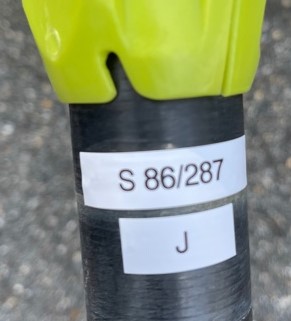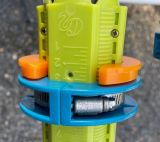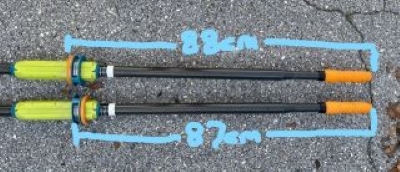Sculling Oar Information
JRC now has 17 sets of sculling oars. They were purchased at various times, but the sleeves and collars have all been recently replaced. Some new grips are also being ordered.
The following discussion provides some helpful information that you should consider when you choose particular sculling oars to use.
What are the differences & how are they marked?
Each of the JRC sculling oars is now labeled with two stickers which are located on the blade side of the sleeve (see example below). The lower sticker shows a letter and simply designates which two oars should be paired together. The top sticker begins with a letter, either S or F, which denotes the blade type, followed by 2 numbers. The first of the 2 numbers is the length of the oar’s inboard (the distance from the end of the handle to the blade side of the oar collar); the second number is the total length of the oar. Both measurements are in centimeters.
Of the 17 sets of oars 13 have been set with an inboard of 87cm, 2 have been set at 86cm, and 2 have been set at 85cm. The 17 sets of oars are about evenly distributed by blade type, labeled S and F. All of the oars have an orange C.L.A.M. initially placed on the handle side of the collar, where it has no effect.

How should I choose a specific set of oars?
Most people will want to use the oars that are set with inboards of 87cm. When rowing in JRC’s quads, which have their span (the distance between the 2 oarlocks) set at 158cm, that will provide you with the conventional amount of crossover between the 2 oar handles. If you are rowing in a JRC single or double, which all have their span set at 160cm, you will have the same amount of crossover between the handles if you move the C.L.A.M. from the handle side of the oar collar to the blade side of the oar collar. By moving the C.L.A.M. to the blade side, the oar’s inboard is increased to 88cm and you will have slightly greater leverage in moving the proportionately heavier single or double through the water. When moving a C.L.A.M. from one side of the collar to the other side, first slide it off of the green oar collar onto the black shaft and ensure that the opening in the C.L.A.M. goes back onto the oar collar matched up with the broader flat surface of the oar collar (see photo below). It will only fit properly in that manner.


What about the different blade types and oar lengths?
When rowing, the oar is a basic lever. All other variables held constant, there is less load to the extent the inboard is longer, the total length is shorter and the blade is smaller. Generally, the JRC oars are set towards the “light” end of the conventional spectrum which tends to be more appropriate for masters rowers. When the blade type has a smaller surface area (labeled with an S), the total length of a JRC oar is typically a little longer than for a blade type that is a little larger (labeled with an F). Most people will not notice a material difference in the feel of the load between any of the JRC oars which are set with 87cm inboards. As a result, personal preference for the size and texture of the different oar grips may be the deciding factors for which set of oars is best for you.
Why are some oars set with inboards of 86cm and 85cm?
Some rowers (typically, those shorter in stature) may find it advantageous to use oars with less inboard than is conventional. For a boat with a fixed span, if the oar’s inboard is shorter, it will allow both the rower’s hips to be further into the stern and their hands to be wider when at the catch. It will also cause the crossover of the handles to be less and the load to be greater.
Do’s and Don’ts
- Do feel free to experiment with different oars in different boats to see what feels best to you.
- Do row with oars from the same set (identical letter on the label) and store them as a set in the oar cabinet.
- Do wash the oars and clean the dirt and oil off of the oar grips after each use.
- Do keep the orange C.L.A.M. on the oar shaft (on either side of the collar).
- Do report any damage or excessive wear and tear to an oar to the Boathouse Steward.
- Do ask a coach if you have any questions about which oars might be best for you.
- Don’t use oars that do not have the above pictured labels. They are privately-owned oars.
- Don’t peel off the labels when washing the oars.
- Don’t try to adjust the length of the oars or their inboard without permission from the Boathouse Steward.
- Don’t use the backs of the oar blades as a braking device or otherwise scrap them on the dock.
- Don’t try to force the C.L.A.M. onto the oar collar with the opening not properly aligned. It will only fit as pictured above.
- Don’t use the oars (or the boat) in a fight with a bridge abutment. The bridge always wins.
